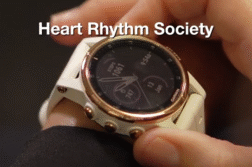PHILADELPHIA, Pa. (Ivanhoe Newswire) — What happens when heart disease is so bad that thick plaque makes it nearly impossible to even place a stent in the arteries? Meet one woman who is part of a clinical trial using shockwaves to fracture that plaque. shockwaves treat heart disease
Fifty-nine-year-old Vickey Soennichsen’s heart disease had filled her arteries with plaque, narrowing them to the point that while trying to catch a train, she almost collapsed.
“I’m going up the stairs and I’m pulling myself up the stairs trying to get up to the top. I thought, I am just gonna die,” said Soennichsen.
Thick plaque buildup constricting her arteries, was the culprit.
Sarang Mangalmurti, MD, Interventional Cardiologist at Lankenau Heart Institute, Main Line Health said, “When you see areas of a vessel that look like bites have been taken out, that represents atherosclerosis.”
Doctors trying to put a balloon or stent in face blockage from calcium that has hardened. So, for years, they drilled the vessel until they discovered shockwave therapy for coronary artery disease, or CAD.
“Instead of drilling out the vessel, we can use a very special balloon that emits ultrasonic waves to crack or fracture all that calcium,” said Dr. Mangalmurti.
The shockwaves are generated from emitters along the context of the angioballoon and connect to a generator.
“That emitter is sparked and that spark creates a shockwave pulse and that pulse is transmitted from the emitter out into the vessel wall,” said Dr. Mangalmurti.
Soennichsen’s recovery was a welcome relief.
Soennichsen said, “They told me to take a week and I felt great the next day. To know that somebody is watching over you and saying you’re going to live, it gives you the confidence to go out and wanna do more.”
CAD therapy will continue trials with 400 patients at 50 hospitals and follow patients for several years. Clinicians will study this until July 2022.
Contributors to this news report include: Cyndy McGrath, Supervising Producer; Donna Parker, Field Producer; Roque Correa, Videographer and Editor.
To receive a free weekly e-mail on Medical Breakthroughs from Ivanhoe, sign up at: http://www.ivanhoe.com/ftk
MEDICAL BREAKTHROUGHS
RESEARCH SUMMARY
TOPIC: SHOCKWAVES TREAT HEART DISEASE
REPORT: MB #4639
BACKGROUND: Coronary artery disease (CAD) is the most common type of heart disease. It is the leading cause of death in the United States in both men and women. CAD happens when the arteries that supply blood to heart muscle become hardened and narrowed. This is due to the buildup of cholesterol and other material, called plaque, on their inner walls. This buildup is called atherosclerosis. As it grows, less blood can flow through the arteries. As a result, the heart muscle can’t get the blood or oxygen it needs. This can lead to chest pain or a heart attack. Most heart attacks happen when a blood clot suddenly cuts off the hearts’ blood supply, causing permanent heart damage. Over time, CAD can also weaken the heart muscle and contribute to heart failure and arrhythmias. Heart failure means the heart can’t pump blood well to the rest of the body.
(Source: https://medlineplus.gov/coronaryarterydisease.html)
TREATMENT: Coronary artery bypass surgery can restore normal blood flow to the heart by creating new pathways around blocked arteries, potentially using grafts from the patient’s own arteries and veins. An opening is made below the blockage. The graft is sewn into the opening to redirect blood flow to the heart. Coronary artery bypass surgery involves using grafts from the patient’s own veins and arteries to form new passageways around blockages. Thoracic arteries in the chest wall are the best grafts, though surgeons continue exploration and perform using veins from the leg, stomach and forearm.
NEW TREATMENT: Sarang Mangalmurti, MD, Interventional Cardiologist at Lankenau Heart Institute talked about the shockwave therapy, “The shockwaves are generated from emitters that are spaced out along the context of the balloon. When we push the button on the balloon that generates the actual process where the emitter is sparked and that spark creates a shockwave pulse. And that pulse is transmitted from the emitter out into the vessel wall.” Dr. Mangalmurti says they are currently in a clinical trial and are seeing good results, “From the results that we’re seeing after we do the treatment, we’re seeing significantly improved vessel compliance. That means the vessel has opened up after the balloon angioplasty portion of it largely because we’ve fractured and weakened that calcification.”
(Source: Sarang Mangalmurti, MD)
FOR MORE INFORMATION ON THIS REPORT, PLEASE CONTACT:
Mary Kate Coghlan
Public Relations Specialist
If this story or any other Ivanhoe story has impacted your life or prompted you or someone you know to seek or change treatments, please let us know by contacting Marjorie Bekaert Thomas at mthomas@ivanhoe.com




